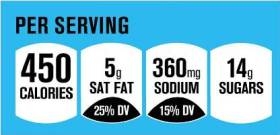If the food industry has its way, shoppers will soon see an at-a-glance view of a product’s nutritional profile on the front of the package, separate from the complete nutritional information. The mini-profile will list the calories, fat grams, milligrams of sodium, and grams of sugar in big numbers (sometimes with a highlighted important “nutrient” noted).
Taken out of context, details like fat grams are not helpful. If fat comes from almonds, for example, great. Fat from a manufactured product like canola oil is a different story.
This new labeling scheme will be like trying to get somewhere only by reading the speed limit sign but not actually consulting a map.
The labels, promoted by the Grocery Manufacturers Association, will show grams and also the percentage of the daily value allowed it accounts for. Even if the Food and Drug Administration does not approve of this labeling scheme, it’s still the USDA’s problematic nutritional guidelines that will be informing the labels.
The government doesn’t consider the source or the complexity of each ingredient as much as the raw number.
Sugar grams that come all from whole fruits, or even whole food sweeteners like honey or molasses – with their fiber and minerals intact – don’t wreak the same havoc on the body as sugar grams from refined sugars. Fat grams from coconut oil are not bad, while fats from partially hydrogenated oils are. So two foods with labels of 5g fat might have vastly different nutritional profiles.
Even though the numbers don’t tell the whole story, it does sound like this scheme isn’t quite as troubling as the Smart Choices program which gave a green check-mark to Froot Loops despite the fact that over 40 percent of the cereal by weight is sugar. According to the Washington Post article on the number labels, Smart Choices was abandoned in 2009 after it was “widely panned by public health advocates and the FDA.”
Even if Froot Loops hadn’t gotten a seal of approval, I still chafe at the idea of someone deciding what is good and bad and giving any kind of thumbs up or down. I mean, at least with the GMA’s new label, I can look at the fat grams and decide for myself that a high number might be good. Smart Choices tries to tell you what conclusion to draw.
Regardless of what new packaging icons come down the line, the only way to really know about a product is to read the entire label.
Or just buy real foods that don’t have labels!
I wrote more about this and other recent food-related health news in this column at the Washington Times Communities.

Leave a Reply
You must be logged in to post a comment.